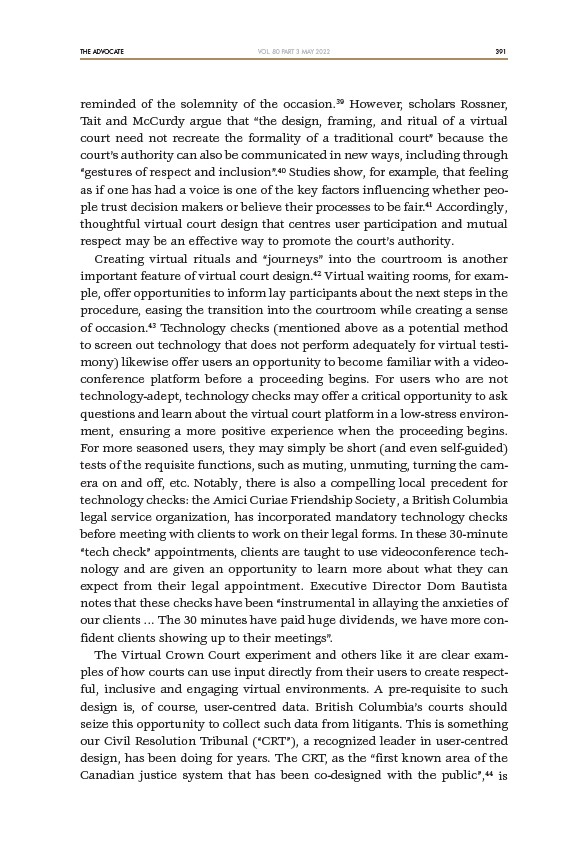
THE ADVOCATE 391
VOL. 80 PART 3 MAY 2022
reminded of the solemnity of the occasion.39 However, scholars Rossner,
Tait and McCurdy argue that “the design, framing, and ritual of a virtual
court need not recreate the formality of a traditional court” because the
court’s authority can also be communicated in new ways, including through
“gestures of respect and inclusion”.40 Studies show, for example, that feeling
as if one has had a voice is one of the key factors influencing whether people
trust decision makers or believe their processes to be fair.41 Accordingly,
thoughtful virtual court design that centres user participation and mutual
respect may be an effective way to promote the court’s authority.
Creating virtual rituals and “journeys” into the courtroom is another
important feature of virtual court design.42 Virtual waiting rooms, for example,
offer opportunities to inform lay participants about the next steps in the
procedure, easing the transition into the courtroom while creating a sense
of occasion.43 Technology checks (mentioned above as a potential method
to screen out technology that does not perform adequately for virtual testimony)
likewise offer users an opportunity to become familiar with a videoconference
platform before a proceeding begins. For users who are not
technology-adept, technology checks may offer a critical opportunity to ask
questions and learn about the virtual court platform in a low-stress environment,
ensuring a more positive experience when the proceeding begins.
For more seasoned users, they may simply be short (and even self-guided)
tests of the requisite functions, such as muting, unmuting, turning the camera
on and off, etc. Notably, there is also a compelling local precedent for
technology checks: the Amici Curiae Friendship Society, a British Columbia
legal service organization, has incorporated mandatory technology checks
before meeting with clients to work on their legal forms. In these 30-minute
“tech check” appointments, clients are taught to use videoconference technology
and are given an opportunity to learn more about what they can
expect from their legal appointment. Executive Director Dom Bautista
notes that these checks have been “instrumental in allaying the anxieties of
our clients … The 30 minutes have paid huge dividends, we have more confident
clients showing up to their meetings”.
The Virtual Crown Court experiment and others like it are clear examples
of how courts can use input directly from their users to create respectful,
inclusive and engaging virtual environments. A pre-requisite to such
design is, of course, user-centred data. British Columbia’s courts should
seize this opportunity to collect such data from litigants. This is something
our Civil Resolution Tribunal (“CRT”), a recognized leader in user-centred
design, has been doing for years. The CRT, as the “first known area of the
Canadian justice system that has been co-designed with the public”,44 is